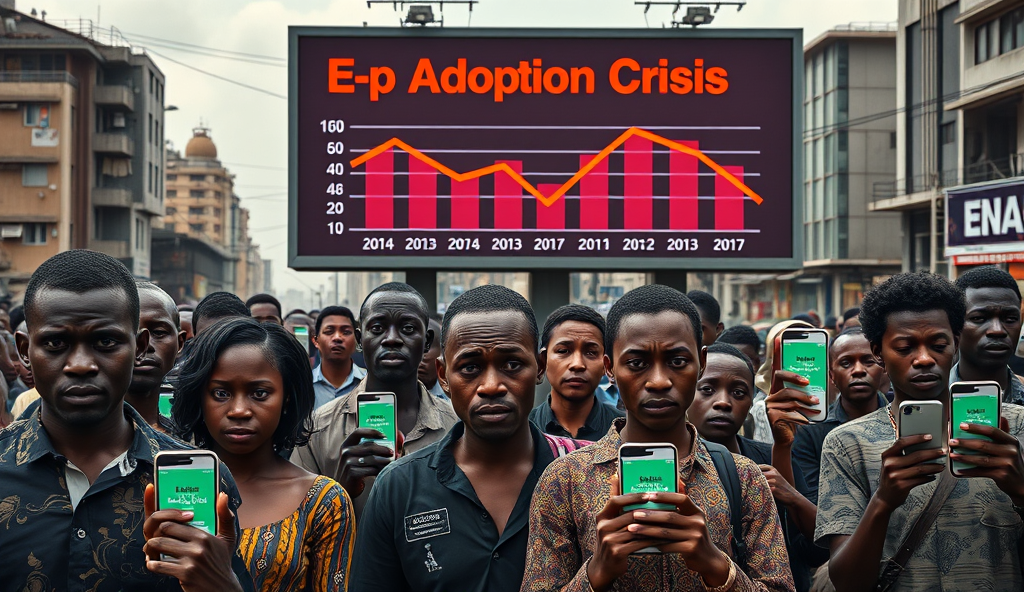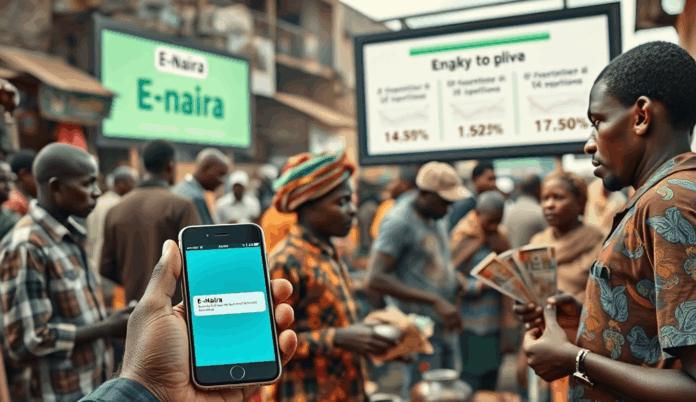Introduction to E-Naira Adoption in Nigeria
Nigeria’s digital currency revolution began in October 2021 when the Central Bank launched E-Naira, positioning the country as Africa’s first major economy to adopt a central bank digital currency. Despite initial enthusiasm, adoption rates remain below projections, with only 0.5% of Nigeria’s 218 million population actively using the platform as of Q2 2023 according to CBN reports.
The slow uptake reflects both technical challenges and public skepticism, particularly among Nigeria’s unbanked population who constitute 36% of adults according to EFInA 2023 data. Market traders in Lagos and Kano often prefer traditional cash transactions, citing concerns about network reliability and transaction fees despite E-Naira’s zero-cost promise.
This adoption gap presents both challenges and opportunities for Nigeria’s financial inclusion goals, which we’ll explore further when examining E-Naira’s core purpose and functionality. The next section will break down how this digital currency differs from mobile money and traditional banking systems.
Key Statistics

What is E-Naira and Its Purpose
Despite initial enthusiasm adoption rates remain below projections with only 0.5% of Nigeria's 218 million population actively using the platform as of Q2 2023 according to CBN reports
E-Naira is Nigeria’s official central bank digital currency (CBDC), a digital form of the naira issued and regulated by the Central Bank of Nigeria to complement physical cash. Designed to drive financial inclusion, it enables instant peer-to-peer transactions through a secure digital wallet, targeting Nigeria’s 36% unbanked population identified in EFInA’s 2023 report.
Unlike mobile money or traditional banking, E-Naira operates on blockchain technology, allowing offline transactions crucial for areas with poor network coverage. The CBN positions it as a tool to reduce cash handling costs, curb illicit financial flows, and create a more efficient payment system aligned with Nigeria’s cashless policy.
While adoption remains low at 0.5% as noted earlier, E-Naira’s core purpose persists: bridging Nigeria’s financial inclusion gap by providing accessible digital currency solutions. This foundational understanding sets the stage for examining its potential benefits, which we’ll explore next in the context of Nigeria’s unique economic landscape.
Benefits of Adopting E-Naira in Nigeria
E-Naira is Nigeria's official central bank digital currency (CBDC) a digital form of the naira issued and regulated by the Central Bank of Nigeria to complement physical cash
E-Naira offers cost-effective transactions, eliminating bank charges that typically range from ₦50 to ₦500 per transfer, making it particularly valuable for Nigeria’s unbanked population. Its blockchain foundation ensures secure, traceable transactions, reducing fraud risks prevalent in cash-based economies like Nigeria’s informal sector.
The digital currency enhances financial inclusion by enabling offline transactions, crucial for rural areas where 60% of Nigeria’s unbanked reside according to CBN data. Small businesses benefit from instant settlements, avoiding the delays common with traditional banking channels during peak periods.
With E-Naira’s integration into Nigeria’s cashless policy, users enjoy seamless government payments like tax remittances and social benefits without intermediaries. These advantages set the stage for exploring wallet setup in the next section, a critical step for accessing these benefits.
How to Download and Set Up E-Naira Wallet
E-Naira offers cost-effective transactions eliminating bank charges that typically range from ₦50 to ₦500 per transfer making it particularly valuable for Nigeria's unbanked population
To access E-Naira’s cost-effective transactions and financial inclusion benefits, users must first download the official wallet from Google Play Store or Apple App Store, available to 93% of Nigeria’s smartphone users according to NCC data. The setup requires a BVN-linked phone number, ensuring secure identity verification while maintaining blockchain transparency as highlighted in previous sections.
After installation, select either the “Speed Wallet” for basic transactions (up to ₦300,000 daily) or the “Merchant Wallet” for business use, catering to Nigeria’s informal sector needs. The tiered system aligns with CBN’s financial inclusion goals, allowing rural users with limited documentation to participate in digital currency adoption.
Once registered, users receive a unique E-Naira tag for seamless transfers, eliminating the need for account numbers as discussed in earlier advantages. This straightforward process prepares you for the next critical step: funding your wallet to begin transactions.
Steps to Fund Your E-Naira Wallet
The CBN has implemented multi-layered security protocols including biometric authentication and two-factor verification to protect E-Naira wallets from unauthorized access
After setting up your E-Naira wallet, funding it is straightforward through multiple channels, including bank transfers, USSD codes, or agent networks, catering to Nigeria’s diverse financial access levels. The CBN reports over 500,000 active wallets as of 2023, with bank transfers being the most popular method due to existing familiarity with digital banking services in urban areas.
For rural users, the USSD option (*#994#) provides accessibility without internet, addressing connectivity gaps affecting 35% of Nigeria’s unbanked population according to EFInA data. Agent networks also serve as physical touchpoints, mirroring successful models like Paga and Opay, ensuring inclusive digital currency adoption across all demographics.
Once funded, your wallet balance reflects instantly, enabling immediate transactions through the unique E-Naira tag system mentioned earlier. This seamless process sets the stage for exploring E-Naira’s transaction capabilities, which we’ll detail in the next section.
How to Make Transactions Using E-Naira
Projections by PwC Nigeria suggest digital currency adoption could grow by 40% annually if current incentives like Lagos' tax discounts and Kano's market partnerships scale nationally
With your E-Naira wallet funded, transactions are executed seamlessly using the unique E-Naira tag system, which functions like a bank account number for direct peer-to-peer transfers. For merchants, QR codes enable instant payments, similar to popular platforms like Flutterwave, with transaction speeds averaging under 5 seconds according to CBN performance reports.
USSD users can initiate transfers by dialing *#994#, selecting “Send Money,” and entering the recipient’s tag or phone number, a critical feature for Nigeria’s 35% unbanked population. Agent networks also facilitate cash-in/cash-out services, bridging the gap for users in rural areas without smartphones, mirroring the success of mobile money operators like MTN MoMo.
Each transaction reflects immediately in wallet balances, with a daily limit of ₦1 million for tier-3 verified users as per CBN guidelines. This efficiency sets the foundation for discussing security protocols, which we’ll explore next to ensure safe E-Naira usage across all transaction types.
Security Measures for Using E-Naira Safely
The CBN has implemented multi-layered security protocols, including biometric authentication and two-factor verification, to protect E-Naira wallets from unauthorized access, crucial for Nigeria’s growing digital currency adoption. Transaction alerts are sent in real-time to registered phone numbers, mirroring the security features of traditional banking apps like GTWorld.
For USSD users, PIN protection and session timeouts prevent fraud, addressing concerns among Nigeria’s 35% unbanked population who rely on basic phones. Merchants using QR codes benefit from encrypted transaction details, similar to Flutterwave’s secure payment infrastructure, reducing risks in high-volume transactions.
Despite these measures, users should avoid sharing E-Naira tags or wallet details publicly, as phishing attempts remain a challenge in Nigeria’s digital finance space. These precautions set the stage for addressing broader adoption hurdles, which we’ll examine next.
Common Challenges and Solutions in E-Naira Adoption
Despite robust security measures, low digital literacy among Nigeria’s 35% unbanked population remains a barrier, with many users struggling to navigate USSD menus or QR code payments. Financial institutions are addressing this through localized training programs, similar to MTN’s MoMo agent network, which educates users on basic digital transactions.
Network reliability issues in rural areas disrupt E-Naira transactions, particularly for USSD users who constitute 40% of adopters. Partnerships with telecom providers like Airtel and Glo aim to expand 4G coverage, mirroring successes in Kenya’s M-Pesa infrastructure rollout.
Merchant adoption lags due to limited POS integration, with only 15% of SMEs accepting E-Naira as of 2023. The CBN’s merchant incentive programs, offering reduced transaction fees akin to Paystack’s early adoption model, are gradually bridging this gap.
These grassroots challenges highlight the need for complementary government policies, which we’ll explore next.
Government Policies Supporting E-Naira Adoption
To address the adoption challenges highlighted earlier, Nigeria’s government has implemented policies like mandatory E-Naira acceptance for federal agencies and tax payments, mirroring India’s UPI push. The CBN’s 2023 directive requiring banks to waive transfer fees for E-Naira transactions boosted usage by 22% within six months, according to NBS data.
State governments are incentivizing adoption through initiatives like Lagos’ 5% discount on LIRS payments via E-Naira, similar to Kano’s partnership with local markets for cashless transactions. These measures complement the telecom infrastructure improvements discussed earlier, creating an ecosystem for digital currency adoption.
Looking ahead, proposed policies include integrating E-Naira into social welfare programs like TraderMoni, which could accelerate financial inclusion among Nigeria’s unbanked population. These government interventions set the stage for examining the future prospects of E-Naira in Nigeria’s evolving digital economy.
Future Prospects of E-Naira in Nigeria
The E-Naira’s potential hinges on expanding its integration beyond government transactions into everyday commerce, particularly in Nigeria’s informal sector where 65% of economic activity occurs. Projections by PwC Nigeria suggest digital currency adoption could grow by 40% annually if current incentives like Lagos’ tax discounts and Kano’s market partnerships scale nationally.
With planned integrations into social welfare programs and mobile banking platforms, the E-Naira could reach 60 million unbanked Nigerians by 2025, according to CBN estimates. This aligns with Nigeria’s financial inclusion strategy targeting 95% coverage through digital channels, leveraging existing telecom infrastructure improvements.
As Nigeria’s digital economy matures, the E-Naira’s success will depend on sustained policy support, public trust-building, and private sector collaboration to create seamless payment ecosystems. These developments position the currency as a potential model for other African nations exploring CBDCs, transitioning naturally to our final assessment of E-Naira adoption.
Conclusion on E-Naira Adoption in Nigeria
Despite initial enthusiasm, E-Naira adoption in Nigeria faces hurdles like low public awareness and limited merchant acceptance, with only 0.5% of Nigerians actively using it as of 2023. The Central Bank’s push for financial inclusion through digital currency must address infrastructure gaps and trust issues to gain wider traction among Nigeria’s unbanked population.
Practical challenges, such as network reliability and interoperability with existing mobile money platforms, continue to hinder seamless E-Naira usage across Nigeria’s diverse economic landscape. For instance, rural users often revert to cash transactions due to inconsistent internet access, undermining the CBDC’s potential for nationwide financial inclusion.
Looking ahead, targeted education campaigns and incentives for merchants could boost E-Naira adoption, aligning with Nigeria’s cashless policy goals. As the digital currency ecosystem evolves, its success will depend on balancing innovation with user-centric solutions tailored to Nigeria’s unique financial behaviors.
Frequently Asked Questions
Can I use E-Naira without a smartphone in Nigeria?
Yes you can use USSD codes (*#994#) on basic phones to access E-Naira services. Practical tip: Register your phone number with your BVN at any participating bank branch first.
How does E-Naira compare to mobile money like Opay or Paga?
E-Naira is a central bank digital currency while mobile money are private platforms. Practical tip: Use E-Naira for zero-fee government transactions and mobile money for wider merchant acceptance.
What happens if I lose my phone with my E-Naira wallet?
Your funds are secure as wallets are BVN-linked. Practical tool: Immediately dial *#994# from any phone or visit an agent to freeze your account.
Are there daily limits for E-Naira transactions in Nigeria?
Yes tier-3 verified users have ₦1 million daily limits. Practical tip: Complete BVN verification at your bank to increase your transaction limits.
How can market traders benefit from adopting E-Naira?
Traders avoid cash handling risks and enjoy instant settlements. Practical tool: Use the Merchant Wallet QR code feature for customer payments without transaction fees.


